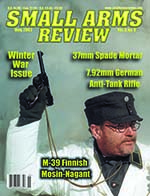When is a Spade Not a Spade? Soviet 37mm Spade Mortar
By Terry Gander
Any soldier soon learns that once the shooting starts in earnest one of the most important items of personal equipment is the entrenching tool. Not only is it essential for creating life-saving cover (or burying casualties), the soldier soon discovers it has many other uses. Apart from acting as an emergency skillet from time to time, it can also act as a very nasty and lethal weapon during close quarter combat; sharp-edged spades were often preferred rather than firearms during the trench raids of the Great War.
The entrenching tool has also found another not immediately apparent use, that of launching explosive packages at an enemy. This notion first appeared in the Soviet Union during the 1930s when someone (it has not yet been discovered whom) proposed that the steel handle of an entrenching tool could be converted into a light mortar barrel. This ingenious proposal was actually developed, manufactured and introduced into limited Soviet Army service during the late 1930s. The concept was simple. When required as a digging tool the tubular steel handle was held rigidly connected to the spade section by an internal steel shaft. Removing the shaft from the end of the handle resulted in a hollow steel tube that became the mortar barrel. The end of the smoothbore tube was hinged to the spade section, converting it into a recoil absorbing baseplate. The internal shaft could also act as a rudimentary monopod support for the barrel.
There is still much to learn regarding this odd little weapon, including what it’s service designation was. It is known that the barrel calibre was 37mm (1.45 inches), with a barrel length of 520 mm (20.47 inches). The complete contraption weighed 2.4 kg (5.3 pounds). The muzzle-loaded, drop-fired bomb (perhaps grenade would be a better term) weighed about 680 grams (1.5 pounds) and the maximum range was about 300 meters (328 yards).
All this data was taken from a German enemy equipment recognition manual dated July 1942, indicating that at least one example must have been captured by them and examined. It seems that the Germans did not know the Soviet designation either, giving it the reporting title of 3.7 cm Spatengranatwerfer 161(r). There the history of the 37mm Spade Mortar then seems to have ended for no indication of the device has been found recorded elsewhere other than the German manual (or at least I have never been able to find any). It seems more than likely that a small batch was issued for field trials just before the Germans invaded. The hard-pressed Soviets then found other more important things to manufacture, rather than what many soldiers must have regarded as little more than an ingenious military toy. The Spade Mortar faded from the scene.
It seemed that the Spade Mortar concept was dead, but it has recently reappeared. Once again the Russians are involved and to make the concept more acceptable for the current era, the projectile launched is a 40mm spin-stabilised grenade, the same type as launched from the GP-25 or GP-30 Kastyor grenade launchers slung under Kalashnikov series assault rifle barrels.
And, once again the correct name for this device is not certain - all I can find is the name Variant but my Russian is non-existent. The overall concept remains the same as before. Removing a shaft from the end of an entrenching tool handle converts the shaft into a short, internally rifled, grenade launcher barrel and the spade section folds to become a baseplate. It appears that the barrel is disconnected to allow a grenade to be inserted into the breech end before the barrel is connected again. Although it is not yet confirmed, the grenade is launched by smartly pulling the barrel down a short distance onto an internal firing pin - I could be wrong here. What appears to be a small drum-pattern sight can be inserted into the fixed section of the shaft below the barrel section. The complete equipment weighs 1.2 kg (2.65 pounds) complete.
The spin-stabilised grenades involved are the readily available 40mm VOG-25 and VOG-25P. Both obtain their propulsion from a charge venting through a ring of orifices in the grenade base. The VOG-25 has a direct impact fuze while the VOG-25P grenade is of the bounding variety. For the latter the impact fuze sets off a small charge which propels the grenade upwards a short distance before it detonates to scatter its lethal fragments over a radius of about 6 meters (nearly 20 feet). Maximum possible range is about 400 meters (437 yards).
The exact status of this present day grenade-launching entrenching tool is still uncertain, as are many other items concerned with this exploratory article, although it has been offered for export sales. Perhaps someone will be able to fill the gaps. In the meantime it is apparent that soldiers have found yet another use for the entrenching tool.
This article first appeared in Small Arms Review V6N8 (May 2003) |
| SUBSCRIBER COMMENT AREA |
Comments have not been generated for this article.





